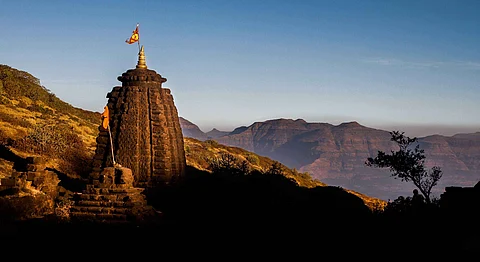
- Home
- न्यूजग्राम
- NewsGram USA
- India
- World
- Politics
- Entertainment
- Culture
- Lifestyle
- Economy
- Sports
- Sp. Coverage
- Misc.
- NewsGram Exclusive
- Jobs / Internships

Harishchandreshwar Temple, Harishchandragad Fort, Maharashtra. (Wikimedia Commons)
Harishchandreshwar Temple is located in Harishchandragad Fort, a hill fort in the Ahmednagar district of Maharashtra, India. This mesmerizing temple is nestled in the greenery of the fort carved out of a single huge black rock. It's an example of ancient Indian architecture of carving sculptures out of stones. The temple is dedicated to Lord Shiva and it is 16 m high in length. The temple is surrounded by caves and ancient water tanks, Mangal Ganga river originates from one of the tanks. There are several caves that have idols of Lord Vishnu inside. The cliffs of the temple are named Taramati and Rohidas. Temple's main entrance has the faces of the guards of the temple sculpted.
Many tombs are also seen in this architecture, which makes this construction a typical amusing sight. The tombs are built by arranging stones one on top of the other. Dedicated to Harishchandreshwar, this temple is built in the architectural style of Hemadpanti. This compilation of different architectural styles in the temple, fort, and of surrounding areas depicts this place has a history of diverse cultures.
The Fort this temple is situated in, Harishchandragad is an ancient fort in the Malshej Ghat. Located at the top of the hill, the Fort is 4,670 ft high from the base and it has played a major role in guarding and controlling the surrounding region. Harishchandragad lies where the boundaries of Thane, Pune, Mumbai, and Ahmednagar districts.
This mesmerizing temple is nestled in the greenery of the fort is carved out of a single huge black rock. (Wikimedia Commons)
The temple is said to have been built in around the 6th century during the rule of the Kalchuri dynasty. However, the architecture of the temple is somewhat similar to North-Indian temples. The caves surrounding the temple are said to be built much later on, probably in the 11th century. It is believed that 'Changdev' the great sage who created the epic Tatvasaar, used to meditate here in the 14th century, evidence of this could be in the temple. There is a Devsnagsri inscription, about saint Changdev on the left side of the temple's entrance.
The carvings on the temple are similar to the temples of Nageshwar and the cave of Kedareshwar which indicate that the temple belongs to the medieval period since it is related to Mahadeva as a totem of tribes Mahadev Koli.
Since the temple is situated on the top of the hill, the only way to reach there is through a trek. (Wikimedia Commons)
Since the temple is situated on the top of the hill, the only way to reach there is through a trek. The temple or the fort could be reached from the nearest three villages-Nalichi Wat, Khireshwar, and Paachnai. The most popular and comparatively easy route to start trekking to the temple is from Khireshwar village. The trek to Harishchandragad Fort offers a lot of scenic beauty during the journey.
Railway – The nearest railway station to Harishchandragad Fort is Igatpuri. It is 40 kilometers away. To reach the base village from Igatpuri, you will have to travel by road.
Airway – The Mumbai Airport is 200 kilometers away. To reach the base village from Mumbai airport, you will have to travel by road.
